The Point about Knives...


The Point about Knives...


The back page from the 1937 Catalog
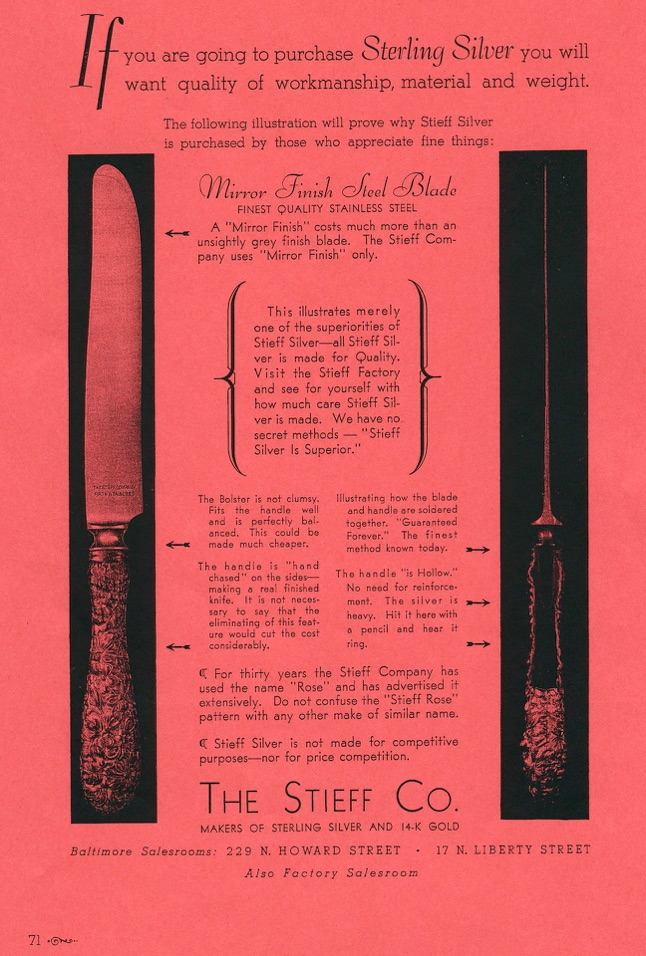
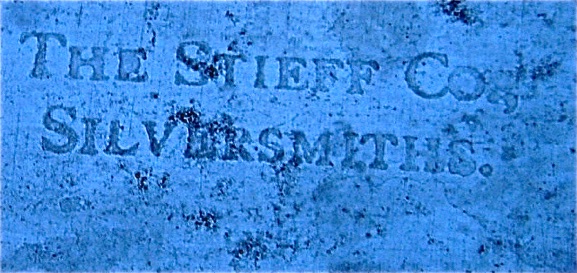
Knives
Blades and Handles
There are three basic knife blades found in Stieff Silver, BLUNT/Old French (1892/1904-early 1930’s) NEW FRENCH(1930’s –late 1960s) and MODERN (1940’s forward), all with overlapping periods of production. All are attached to Sterling Hollow Handles (HH). Often you will see Blunt knives refered to as Old French. The term FRENCH has to do with the style of the blade and not a country

BLUNT blades are round on the ends, hence the name “blunts”. Blunt’s are symmetrical and balanced. When Charles C. Stieff first started making silver this is the type of blade used. The blades were carbon steel, plated in silver. On these early knives, lengthwise on the blade is stamped THE STIEFF COMPANY and under that is SILVERSMITHS. The handles are stamped STERLING just under the bolster. The bolster is that small concave area where the handle meets the blade. Later knives often have no bolster.
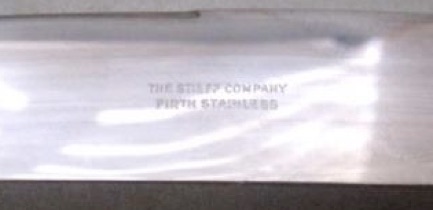
Stainless steel blades were invented in 1913 by Harry Brearley, who worked for Thomas Firth and Son in England. The “FIRTH” blades became popular in the United States in the 1920’s and many Stieff blunts are marked at the base of the blade…THE STIEFF COMPANY and underneath FIRTH STAINLESS or THE STIEFF COMPANY and FIRTH STAINLESS on the length of the blade (as on silver plated blades) with Wade & Butcher on the base of the blade.
Wade & Butcher was a historic steel manufacturing company in Sheffield England who made the Firth stainless under license from Thomas Firth and Son.
Firth went out of business in 1959
In the early 1920’s Stieff was offer a choice of Stainless Steel blades or Silver Plated blades. Stainless added 3.00 per dozen.
The 1936 illustration at the top of the page states that the “mirror finish” is superior to the unsightly grey finish of other blades. If you own knives that are not stainless.. you own those “unsightly grey finish blades”. Imagine the thoughts of silver owners to see their older but still serviceable knives defamed by the company that made them. They state that Stieff only uses “mirror finish”. That may have been the case in 1936, but it had not always been so. Stainless blunt blades were somewhat more reflective, but not as much as the later mirror blades.
An Important Note:
During WWII, competitor Kirk & Son notes in a 1943 price list that due to the rationing of stainless steel that silver plated carbon steel blades would be used as a substitution (on luncheon knives) instead of the standard stainless steel blades. I would think that these plated blades must have come from old early 1920‘s stock in the warehouse. I would imagine that the same thing could have been happening across town at The Stieff Company. So, there could be some Stieff plated blades out there that were assembled during the war too. Of course, production of all silver came to a crawl during the was as manufacturing in America turned to the war effort. Both Stieff and Kirk converted most of the factories to war efforts.
Below is a comparison of a plated steel blade and a stainless “mirror finish” blade. I left my camera in the photo so you can see the reflective differences.
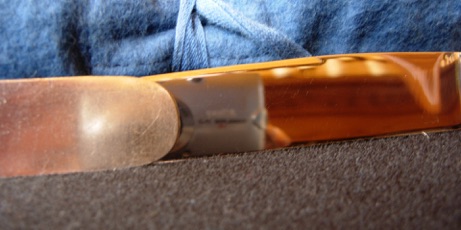
Here is a comparison of three knives, the silver plated Blunt. a stainless Blunt and the mirror finish introduced in the 1930’s.The top knife is a dinner, the others luncheon/place knives. The reflective quality improves through the years.
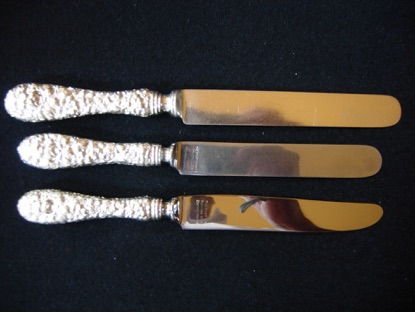
Later the FIRTH wording on the blades was dropped and Stainless became the standard. Keep in mind that “stainless” means “stains less” and not stain proof. The blades can still become stained especially if exposed to heavy acids that are left to dry on the blades. So be careful when cutting Tomatoes, Lemons and Limes etc. as these can all create bad stains on your stainless steel blades.


The BLUNTS are also known as Old French. All French blades have a small extension creating a 90 degree angle at the bottom of the blade just above the bolster. Pictured here are French blades and examples of bolster and no bolster.

(Until I can take a photo of a Stieff knife, this is an example using a KIRK knife)
Depending on the year some blades are marked Stainless blade, Sterling handle while others are marked sterling on the handle and stainless on the blade.
A Word of Caution when buying knives.
Be aware that not all knife handles are attached to the blades that they started with. Over the years if a blade was broken, or miss-sharpened (which happened a lot) jewelers and other trades people would exchange blades from a knife with a damaged handle. This is why you might see a Reed & Barton blade on a Stieff handle or a Tiffany and Company blade for the same reason. If you are buying a blunt knife.. take a close look at the blade to see that it is straight, top and bottom and round on the end... and not tapered due to a bad sharpening job. Sometimes the repairer would fill the hollow blade with a fine cement of some sort to anchor the blade in place, making a handle that is not well balanced and much heavier than it should be.
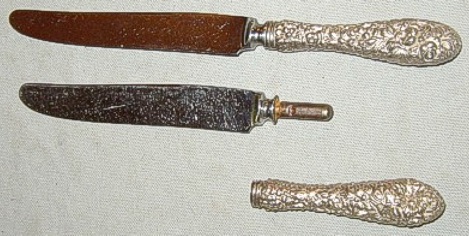
Early pieces were actually filled with pitch and when placed in a dishwasher.. the heat melts the pitch and the blades become loose or can fall out. Later pieces did employ some cements in addition to the solder to anchor the blade.
As I have discussed elsewhere in this writing... some of the “used silver” companies employ this practice to create “new” styles by joining hollow handles with modern blades or utensils of some sort to make something to be sold on Ebay. An example of this is the hooded asparagus server that is now offered with a stainless “server” attached to a Stieff Handle. Another is cake and bread knives with Sheffield blades. Also Ladles, BBQ sets, an assortment of serving pieces are now offered with someone else’s stainless attached to an old Stieff handle.
This is not something that Stieff ever made, but many of them can be fun and charming. The same can be said about some spoons and forks that have been repurposed over the years by highly skilled silversmiths.
When buying on-line.. if there is any doubt as to the construction of an item...be sure to ask the seller questions before you buy. Ask if they are doing the work themselves (or buying them made that way) and how the pieces are attached.
(glue, epoxy, spit?) And be sure to find out what the return policy is if you are disappointed by your purchase.
A Change of Thinking...
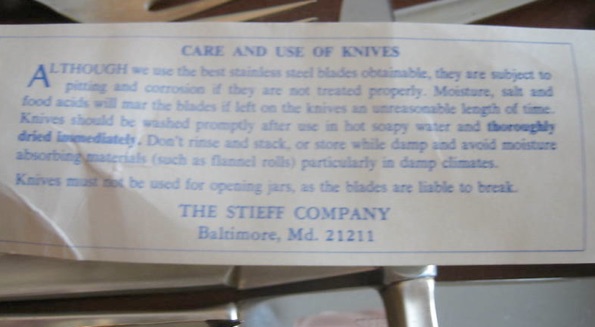
This is from a set of Knives in the Personna Pattern
Note that they recommend not storing your silver in flannel cloth rolls. For years Stieff had provided those same cloth rolls to clients.
Research must have proven that it was not such a good idea.
You may contact me at:
Steak Knives
For years the Dinner and Place knives soldiered on as the main cutting tool. Using one of those knives to cut a thick chop or steak... I am not sure how one would manage that with a certain amount of grace, it works but there is a lot of cutting and sawing. The blades are sharp enough for chicken or turkey... but even a tender piece of beef like Filet Mignon can be a challenge.
In 1939, a Steak Knife was added to the line. Stieff called the blade a “saw edge”. This was a new french blade with bolster. Length was 9.5 inches long.

Later, as demand increased, Steak Knives in the Modern style were added with what Stieff called “straight-razor thin” blades.
These next two photos are of my steak knives. The handles are hand chased. The blades are modern. They came with the paper knife blade protector on them.. but cut in half. (These are the sleeves from carving knives) Note the use of the 5 digit zip code. This means that they were made in or after 1963 which is when the 5 digit zip code numbers went into use.
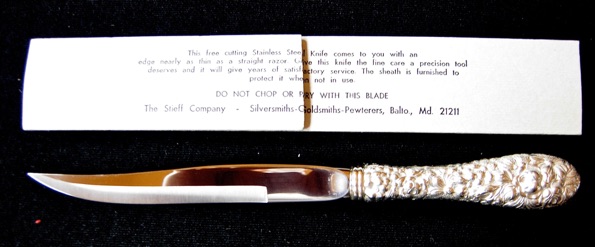
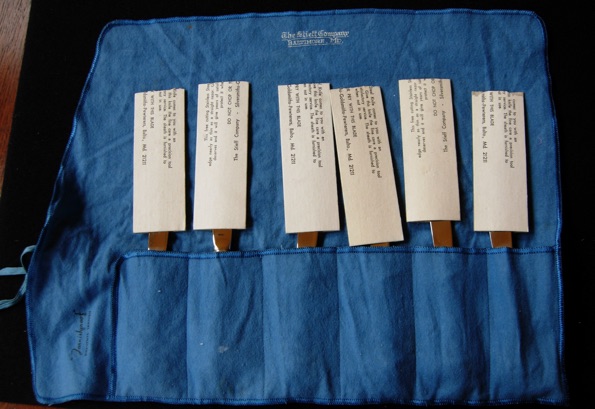
Handles
Handles on Stieff Knives are hollow handles as shown in the red illustration at the top of the page. The handles were made in two parts and joined along the edges. These edges were then finished in what is called Hand Chasing. A craftsman would use small tools to join the patterns of the two parts to make it look like a solid piece. In later Kirk-Stieff pieces this craftsmanship went away.
In the photos below you can see the difference in the two. The handle on the left is a Stieff handle and the one on the right is a Kirk-Stieff piece. Note the lack of detain on the right side example.
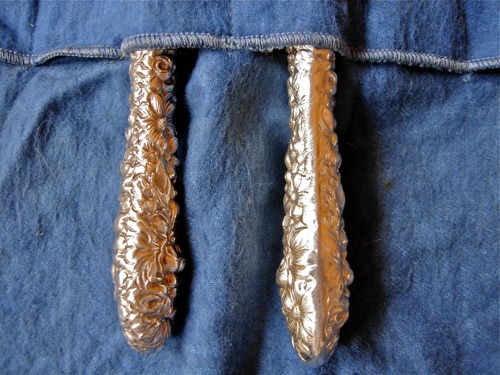
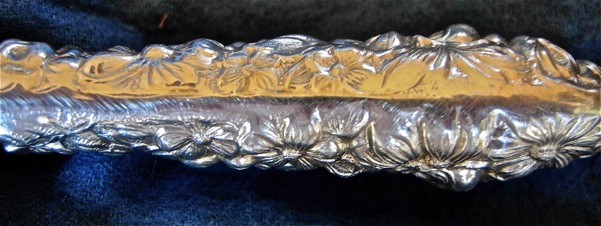
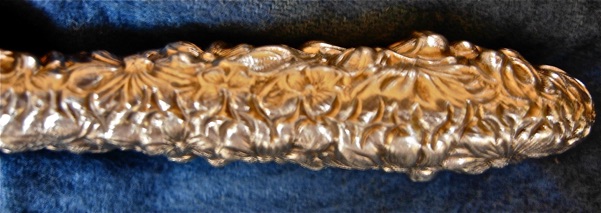
Above are close ups of the same two pieces. The superior quality of the Stieff piece stands out when compared to the Kirk-Stieff piece. I can not really fault Kirk-Stieff for going this route. The world had changed, silver was not important in most peoples lives and prices had to be brought down.. or at least not raised in order to compete in the market place. When silver production left Baltimore for Smithfield RI in 1999 (and later New Jersey) (now Puerto Rico) the craftsmen that had served the company for so many generations... stayed in Baltimore.
This is what the inside of your knives look like. The seam has ripped on this knife.. exposing the interior which is filled with rosin/cement to add weight and balance to the knife. Notice how thin the silver actually is on a knife handle.. about that of a business card.
This is a good example of why we should be careful with our silver knives.
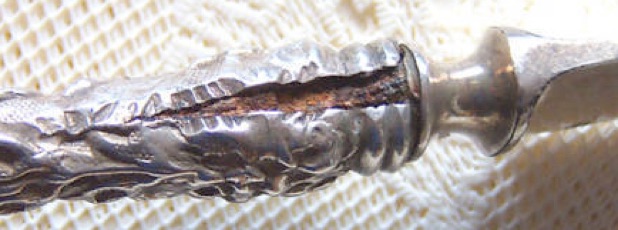
The repair of a knife damaged like this would cost more than the value of the knife.
NEW FRENCH blades have a curved blade shape. They also retain the classic French blade 90 degree angle at the base. (see below) Note that the tip of the knife tapers to a softer, more pointed blade tip than the blunt blades of earlier years. The top of the blade creates a bit of a curve downward as it reaches the tip and and a ever so slight upward curve along the bottom edge of the blade as it races towards the bolster at the base.

Stieff introduced the New French blade style in the early 1930’s while continuing for a while to make the blunt blades for those who still needed to match the older style. Remember that most people were buying or receiving silver a piece or two at a time and it could take years to complete a set. One did not want to change knife styles in mid-collection. This form was made by Stieff Silver into the late 1960’s as orders for the New French blade kept coming in from people who had received mother’s silver and wanted to expand the collection.
MODERN Blades…In the post war 1940’s many people wanted to modernize everything. This cultural shift eventually came around to silver too, as modern brides wanted new styles and patterns of silver. With this desire for everything new came the MODERN knife form, which removed the bolster and the refined the blade. At the same time Stieff brought out many new patterns.
As seen below, the new modern knife blended effortlessly from blade to handle.


This is the style in which most modern silver is made, including the current Kirk-Stieff pieces by Lifetime Brands. (shown below)

There is some confusion amongst some collectors (and Ebay sellers) as to what is a dinner knife vs a place knife. The 1937 & 1939 catalogs gives the measurements of each. Begining in the late 1950‘s and early1960’s the dinner and place/luncheon sizes discontinued and one size knife.. at 9 inches was offered.
In the “setting the table” section of this site...there is a 1950’s guide that explains when to use the various pieces of sterling silverware.
The Stieff Company made a lot of sharp knife types. These included Dinner knives which were 9 ½ inches long, Place knives (aka Luncheon and Medium knives) at 8 ¾ inches long. An assortment of special carving knives with and without guards abounded as well as cake and bread knives, as shown on pages 24 and 25 of the 1937 catalog.
Here is a early fruit knife with a silver plated steel blade. Later fruit knives have a sharp underside and a serrated top. The top for cutting tough skinned fruits and the bottom for softer pieces. Mine have blades that bend ever so slightly to the right which makes them good for cutting grapefruit away from the rind.
They also make perfect bar knives for lemons and limes.
An Early Fruit Knife
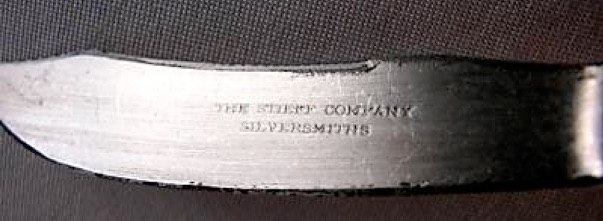
Shield Handles
For years, Stieff offered two types of handles. Regular and Shield. The Shields were on the inside of the handle, so that when the table was set with the blade towards the plate...the shield would be shown. As best as I can tell, the shields were offered from the 1890’s through the 1920s.
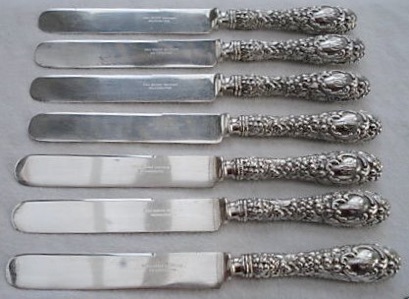
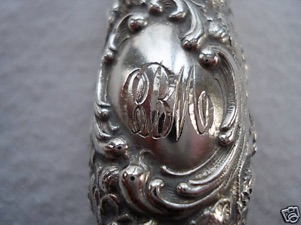
This site, THESTIEFFCOMPANY.COM receives no money or compensation from any of the references or companies listed on this site. We wish to thank others for the use of material from their sites and it is published here as an educational tool only. Some images have come from unknown original sources. If I have used your image without credit or if it needs to be removed, please contact me. We encourage visitors to venture to the other sites shown on this one to learn more about silver and view the images of craftsmanship that they share with all of us. Ad revenues from the google ads helps me maintain this site for the use by silver collectors and those who are just “wondering” about their grandmothers silver and what’s what in the silver chest. I do not make a profit from the publication of this site, it is for educational purposes only.

